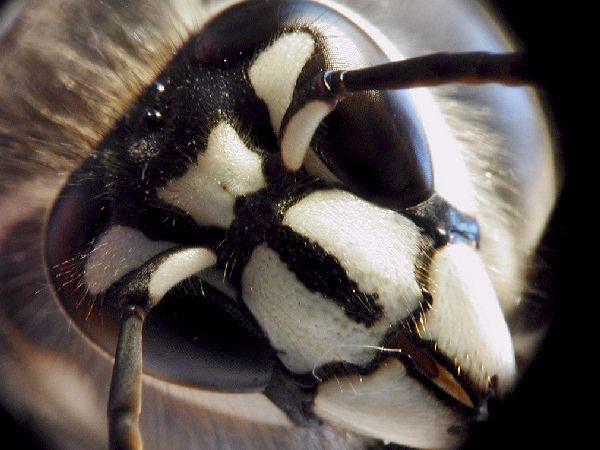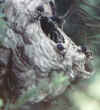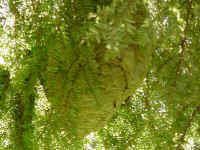Bald-faced hornet / White-faced
hornet
|
|
|
|
|
And not really a Yellowjacket, but pretty darn close, this wasp lives in wooded regions. The nests are constructed of a paper-like martial formed from chewed wood. This species constructs almost exclusively gray football-shaped aerial-nests attached to trees and buildings (but they may exceed a basketball in diameter or even the nest may grow to be larger by the end of the summer).

photo: Rita Gale
The nests are conspicuous and are sometimes near human structures. Many nests are discovered at the end of the summer, after protecting leaves fall from trees. It is often best to do nothing at this time except be aware of avoiding the nest and you could even mark out a caution zone so that others are not surprised. Occasionally, the wasps will build nests under roof overhangs, in attics, crawlspaces and wall voids, or under decks or porches. Foragers are present from June to October.
If you are interested in collecting these paper nests, remember that the colony can be active until early November. Visit our own page "How to preserve a Hornet nest" later!
Hornets are attracted to light! Switch it off and open the window, if a hornet found a way into your house. Then the hornet will leave the room from alone.
Bald-Faced-Hornets
and other Wasp colonies have a distinct caste system. It includes:
1. Workers => infertile females which do the labor of the
nest and defend the colony with their stings.
2. Queens => fertile females which lay eggs
3. Drones => fertile males which mate with the future
queens
(by the way: the males do not have stingers and
they are born from unfertilized eggs)
click on thumbnails to enlarge the images

photo: Dr. med. Alexander Lang, Toronto
IMPORTANT: Bald-Faced-Hornets, like the European Hornets, are only aggressive when threatened! But the last thing you want to do is to disturb a nest of bald-faced hornets, considering there may be between 400 and 700 workers per colony. If you will disturb them too much, they vigorously defend their nest by stinging any nearby intruder.
Hornets, Yellowjackets and Paper Wasps should not be needlessly killed unless their nests are located in High-Risk-Areas!
Bald-Faced-Hornets take mostly live prey; they prefer to feed on flies and other insects. But sometimes, Bald-faced Hornets like also visiting flowers for nectar!
Also almost always aerial nesting (exposed hanging from branch or structure) do the sometimes called "The Yellow Hornet" or Aerial Yellow Jacket" Dolichovespula Arenaria
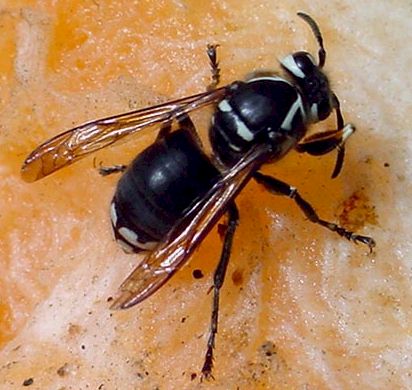
picture taken by Arlene Ripley
Special thanks to William T. Prouty for support in this webpage. Here is his opinion about BALD-FACED-HORNETS: "You are very lucky to have the chance to watch a colony of bald-faced hornets (Dolichovespula maculata) at close range. Speaking from personal experience, they are fascinating and fun to watch! I firmly believe that we, in North America, are truly blessed to have the bald-faced hornet native to our continent alone."
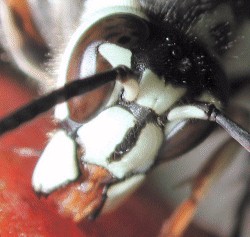
Credit for the above picture goes to the Biology
Department Jacksonville State University
For the interested reader, special biological literature is required to offer a broader spectrum of knowledge about these wasps!

Credit for the above diagram goes to the U.S.
Department of Agriculture
next page: Bald-Faced Hornets, Part 2!
Hymenoptera>Vespoidea>Vespidae>Vespa
crabro>Hornisse>Hornet>Frelon>Hoornaar>Vespa
grande>Abejorro>Calabrone
Hymenoptera>Vespoidea>Vespidae>Vespa
crabro>Hornisse>Hornet>Frelon>Hoornaar>Vespa grande>Abejorro>Calabrone
Webmaster:
Dieter Kosmeier
Hymenoptera>Vespoidea>Vespidae>Vespa
crabro>Hornisse>Hornet>Frelon>Hoornaar>Vespa grande>Abejorro>Calabrone
Hymenoptera>Vespoidea>Vespidae>Vespa
crabro>Hornisse>Hornet>Frelon>Hoornaar>Vespa grande>Abejorro>Calabrone
